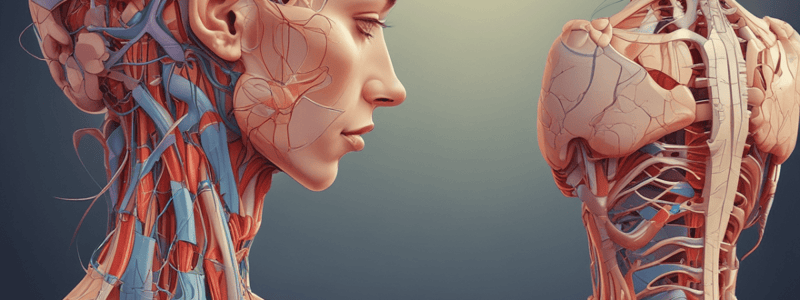Podcast
Questions and Answers
What is the primary function of the epidermis?
What is the primary function of the epidermis?
What is the composition of the dermis?
What is the composition of the dermis?
How often is the entire epidermis replaced?
How often is the entire epidermis replaced?
What is the function of the hypodermis?
What is the function of the hypodermis?
How many layers of epidermis are found in the skin on the palms and soles?
How many layers of epidermis are found in the skin on the palms and soles?
What is the skin's role in vitamin D production?
What is the skin's role in vitamin D production?
What is the function of Langerhans cells in the skin's immune system?
What is the function of Langerhans cells in the skin's immune system?
What is the main difference between people with different skin tones?
What is the main difference between people with different skin tones?
What is the function of the papillary layer of the dermis?
What is the function of the papillary layer of the dermis?
Why is the skin's regeneration process influenced by its avascular nature?
Why is the skin's regeneration process influenced by its avascular nature?
What is the function of the basal layer of the skin?
What is the function of the basal layer of the skin?
What is the importance of sunscreen in protecting the skin?
What is the importance of sunscreen in protecting the skin?
Flashcards are hidden until you start studying
Study Notes
• The skin is often overlooked as an essential organ, despite its importance in protecting the body from external factors, regulating body temperature, and aiding in the production of vitamin D.
• The skin is composed of three layers: the epidermis, dermis, and hypodermis, each with unique cells and functions that work together to perform its various roles.
• The epidermis is the outermost layer, visible to the eye, and is composed of stratified squamous epithelium; it's responsible for protecting the body from external factors and provides a barrier against water loss.
• Beneath the epidermis lies the dermis, where most of the skin's functions take place, including sweat production, blood circulation, and sensation; it's composed of a dense network of nerve endings, blood vessels, and hair follicles.
• The hypodermis, also known as subcutaneous tissue, is the innermost layer, composed mainly of fatty tissue, which provides insulation and cushioning for the body.
• The skin's layers are organized differently in various parts of the body, with thicker skin on the palms and soles, containing five layers of epidermis, and thinner skin elsewhere, with only four layers.
• The epidermis is constantly shedding and regenerating, with millions of cells replaced daily, and the entire epidermis replaced every 4-6 weeks.
• The melanocyte cell is responsible for producing melanin, which gives the skin its color; despite differences in skin tone, all humans have a similar number of melanocytes, with variations in their extensions and melanin production.
• The skin's immune system includes Langerhans cells, which originate in the bone marrow and migrate to the epidermis, where they engulf and digest foreign substances.
• Merkel cells, found at the boundary between the epidermis and dermis, are responsible for sensing touch and pressure, and work together with nerve endings to create a sensitive receptor.
• The skin's layers can be penetrated by external factors, such as a sharp object, which can damage or breach the skin's defenses, leading to infection or injury.
• The skin's regeneration process is influenced by its avascular nature, relying on the dermis for oxygen and nutrient supply, which can lead to cell death and shedding as cells move towards the surface.
• The deepest and most delicate layer of the skin is the basal layer, which is a single layer of columnar cells, similar to a factory that produces new cells. • The basal layer connects the skin to the dermis layer below, which is responsible for producing new skin cells. • The dermis layer contains collagen and elastin fibers that maintain the skin's strength and elasticity, as well as nerve fibers, blood vessels, and hair follicles. • The dermis layer is divided into three sub-layers: the papillary layer, the reticular layer, and the hypodermis layer. • The papillary layer is the most superficial layer of the dermis, consisting of a thin plate of loose connective tissue with finger-like projections called dermal papillae. • These dermal papillae are responsible for forming fingerprints on the skin. • The reticular layer is the deepest and thickest layer of the dermis, making up 80% of the dermis, and is composed of dense, irregular connective tissue. • The reticular layer contains all the vital parts of the dermis, including nerve fibers, blood vessels, and hair follicles. • When the skin is injured to the point of bleeding or pain, it means the injury has penetrated the epidermis and reached the dermis. • The hypodermis layer is the deepest layer of skin, composed of loose fatty tissue that provides insulation, energy storage, shock absorption, and helps to anchor the skin. • The hypodermis layer is where most of the body's fat is stored. • The skin's relationship with sunlight is complex, and excessive exposure can cause damage to the skin, including DNA mutations, leading to skin cancer. • Sunscreen is essential to protect the skin from the harmful effects of UV radiation. • The skin contains immune cells that help to defend against infection and disease.
Studying That Suits You
Use AI to generate personalized quizzes and flashcards to suit your learning preferences.




